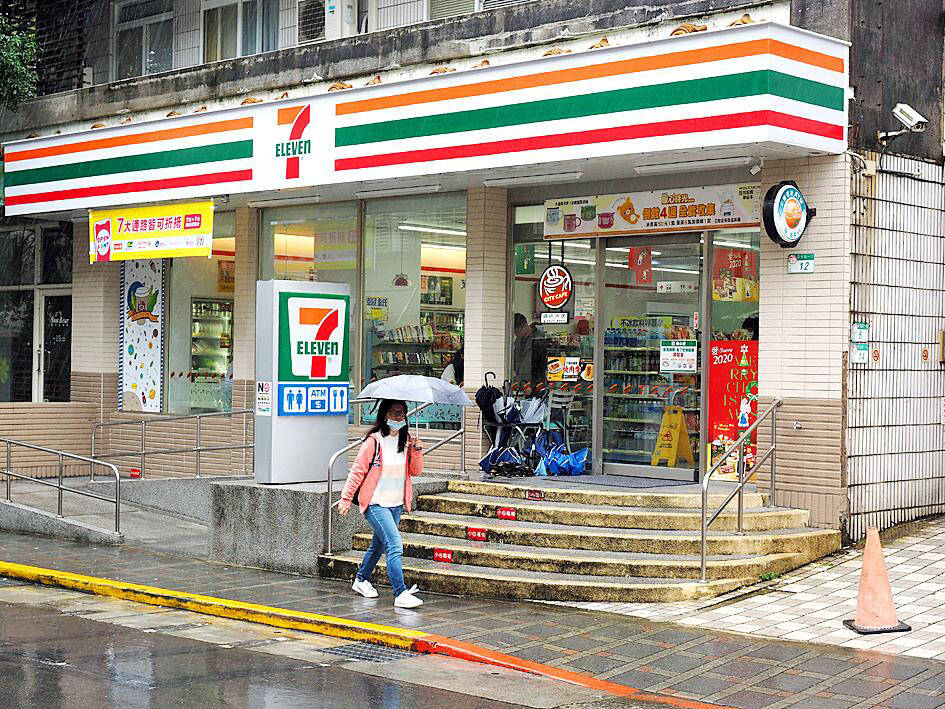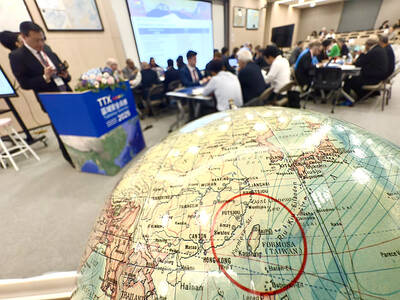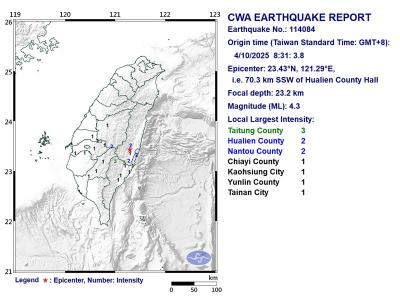The Presidential Office yesterday denied a foreign news report suggesting the government plans to use tens of thousands of convenience stores as “wartime hubs” in the event of a cross-strait war, saying it has no such specific plan.
The Guardian on Saturday reported that if domestic rail lines were shut down, airspace was closed to commercial traffic, and Internet and phone services were disrupted during a Chinese invasion, Taiwanese could seek help from local convenience stores.
“If all this happened, Taiwanese residents could walk to one of the island’s more than 13,000 convenience stores to pick up rations and medical supplies, delivered by the chains’ own logistical transport systems,” the report said, citing four unnamed sources familiar with discussions.

Photo: EPA-EFE
They could read government communications which have been faxed to the stores and displayed on the window. Or maybe they would be able to send a message using the store’s emergency hotspot,” it added.
The idea was being discussed by President William Lai’s (賴清德) Whole-of-Society Defense Resilience Committee, which aimed to make Taiwanese society more resilient in the event of an attack or natural disaster, the article said.
Responding to the report, Presidential Office spokesperson Karen Kuo (郭雅慧) yesterday said the idea of turning civilian distributors into emergency hubs had been brought up by retail industry representatives during meetings of the Whole-of-Society Defense Resilience Committee.
Representatives shared how they supported the public after the 921 Earthquake, Kuo said.
Although that was useful information for the government, the administration has not begun making the type of plans mentioned in The Guardian report, she said, adding that the government already has a plan for setting up wartime stations to distribute strategic materials.
The committee has pledged to enhance Taiwan’s resilience by training civilian forces, securing strategic and critical supplies, reinforcing energy and key infrastructure, and ensuring the continued operations of medical, transportation, information and financial facilities. It has so far held three rounds of meetings, most recently on March 27 during a civil defense drill in Tainan.
The Guardian also said that they expect “Taiwan’s military and maybe police will be sent to frontlines, leaving civilian first responders in charge of care and control.”
Kuo also denied that, saying that police would not be sent to the frontlines and emphasizing that they would be responsible for maintaining social order and logistics, and safeguarding key infrastructure during wartime.

Taiwan is stepping up plans to create self-sufficient supply chains for combat drones and increase foreign orders from the US to counter China’s numerical superiority, a defense official said on Saturday. Commenting on condition of anonymity, the official said the nation’s armed forces are in agreement with US Admiral Samuel Paparo’s assessment that Taiwan’s military must be prepared to turn the nation’s waters into a “hellscape” for the Chinese People’s Liberation Army (PLA). Paparo, the commander of the US Indo-Pacific Command, reiterated the concept during a Congressional hearing in Washington on Wednesday. He first coined the term in a security conference last

DEFENSE: The National Security Bureau promised to expand communication and intelligence cooperation with global partners and enhance its strategic analytical skills China has not only increased military exercises and “gray zone” tactics against Taiwan this year, but also continues to recruit military personnel for espionage, the National Security Bureau (NSB) said yesterday in a report to the Legislative Yuan. The bureau submitted the report ahead of NSB Director-General Tsai Ming-yen’s (蔡明彥) appearance before the Foreign and National Defense Committee today. Last year, the Chinese People’s Liberation Army (PLA) conducted “Joint Sword-2024A and B” military exercises targeting Taiwan and carried out 40 combat readiness patrols, the bureau said. In addition, Chinese military aircraft entered Taiwan’s airspace 3,070 times last year, up about

A magnitude 4.3 earthquake struck eastern Taiwan's Hualien County at 8:31am today, according to the Central Weather Administration (CWA). The epicenter of the temblor was located in Hualien County, about 70.3 kilometers south southwest of Hualien County Hall, at a depth of 23.2km, according to the administration. There were no immediate reports of damage resulting from the quake. The earthquake's intensity, which gauges the actual effect of a temblor, was highest in Taitung County, where it measured 3 on Taiwan's 7-tier intensity scale. The quake also measured an intensity of 2 in Hualien and Nantou counties, the CWA said.

The Overseas Community Affairs Council (OCAC) yesterday announced a fundraising campaign to support survivors of the magnitude 7.7 earthquake that struck Myanmar on March 28, with two prayer events scheduled in Taipei and Taichung later this week. “While initial rescue operations have concluded [in Myanmar], many survivors are now facing increasingly difficult living conditions,” OCAC Minister Hsu Chia-ching (徐佳青) told a news conference in Taipei. The fundraising campaign, which runs through May 31, is focused on supporting the reconstruction of damaged overseas compatriot schools, assisting students from Myanmar in Taiwan, and providing essential items, such as drinking water, food and medical supplies,